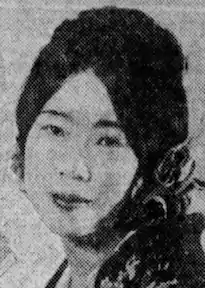Hizi Koyke
Hizi Koyke (1902 – September 1991), born Koike Hisako, was a Japanese singer based in the United States.
Hizi Koyke | |
|---|---|
 Hizi Koyke, from a 1928 newspaper. | |
| Born | Koike Hisako 1902 Tokyo |
| Died | September 1991 New York |
| Occupation | Singer, opera director |
| Relatives | Fortune Gallo (father-in-law) |
Early life
Koike Hisako was born in Tokyo, the daughter of a glass manufacturer. She attended a Methodist missionary school[1] and moved to New York in 1923[2] to attend Columbia University to train as a teacher.[3] While in New York, she took voice lessons with Edythe Magee, and attended the Metropolitan Opera to learn more about Western opera.[4]
Career
Koyke was nearly always cast in Asian roles, especially as Yum-Yum in The Mikado,[5] and with the San Carlo Opera Company[6] as Cio-Cio-San in Puccini's Madama Butterfly, a role she studied under Tamaki Miura.[7][8] She made her New York debut in 1927, in David Belasco's Madame Butterfly,[9] and continued playing in productions of that show for several years, across the United States and Canada.[2][10][11] For added authenticity, she designed her own costumes.[12] She also appeared in Mascagni's Iris (1930), The Geisha (1931),[13][14] and Leoni's L'Oracolo (1937). She gave recitals[15][16] and sang on radio through the 1930s.[4] "Koyke is Butterfly," commented critic Samuel T. Wilson in 1932, "not merely because of her nationality but because she is a fine singer, a most talented actress, and, in the best sense of the word, an artist."[17]
Koyke's career was interrupted by the attack on Pearl Harbor and the United States' entry into World War II, when a Japanese singer and shows with Japanese themes were not welcomed by American audiences. But she resumed her singing after the war, returning to her signature role[18] in Madame Butterfly in 1946.[19] She sang in Butterfly until at least 1950,[20] and retired from the stage in 1955, but continued working in opera as a director with the Chicago Lyric Opera.[4] She was featured in a 1964 educational program about opera on a Texas public television station, aimed at schoolchildren who would be attending an opera in Dallas.[21]
Personal life
Koyke married fellow singer Harald Hansen in 1932; they divorced in 1940.[22] She married again to Edward Mario Gallo, son of opera producer Fortune Gallo.[23] She died in New York in 1991.[4]
References
- "Missionary Discovered Hizi Koyke's Voice". The Boston Globe. 1938-11-11. p. 24. Retrieved 2020-10-02 – via Newspapers.com.
- "Star Notes Revival of Grand Opera". Star-Phoenix. 1935-09-10. p. 6. Retrieved 2020-10-02 – via Newspapers.com.
- Swan, Gilbert (1931-05-15). "It's Cherry Blossom Time on Broadway". Messenger-Inquirer. p. 9. Retrieved 2020-10-02 – via Newspapers.com.
- Robinson, Greg (September 12, 2019). "The Great Unknown and the Unknown Great: Hizi Koyke: Dramatic soprano". Nichi Bei. Retrieved 2020-10-02.
- "'The Mikado'; Hizi Koyke a Hit in Revival at Erlanger's". The Brooklyn Daily Eagle. 1931-05-05. p. 21. Retrieved 2020-10-02 – via Newspapers.com.
- "Noguchi Memorial Programs Singer of Far-Away East". The Cincinnati Enquirer. 1928-11-18. p. 69. Retrieved 2020-10-02 – via Newspapers.com.
- Yoshihara, Mari (2004). "The Flight of the Japanese Butterfly: Orientalism, Nationalism, and Performances of Japanese Womanhood". American Quarterly. 56 (4): 997. doi:10.1353/aq.2004.0067. ISSN 0003-0678. JSTOR 40068292. S2CID 145288396.
- Phillips-Matz, Mary Jane (2002-10-03). Puccini: A Biography. UPNE. p. 129. ISBN 978-1-55553-530-8.
- "Japanese Soprano Hailed in Debut; Hizi Koyke Sings Finely Madame Butterfly in the San Carlo Company's Production". The New York Times. 1927-11-10. ISSN 0362-4331. Retrieved 2020-10-02.
- Goldenburg, William Smith (1929-07-23). "High Artistry is Reaffirmed by Gifted Japanese Singer in 'Madame Butterfly' Role". The Cincinnati Enquirer. p. 2. Retrieved 2020-10-02 – via Newspapers.com.
- "5,000 HEAR 'BUTTERFLY.': Hizi Koyke and Others Receive Ovation at Hippodrome". The New York Times. December 9, 1934. p. N6 – via ProQuest.
- "Singer Makes Own Costumes". Arizona Daily Star. 1931-06-21. p. 21. Retrieved 2020-10-02 – via Newspapers.com.
- Allen, Kelcey (October 9, 1931). "Jas. T. Powers Again Sparkles In Revival Of 'The Geisha' By Aborn: The Cast". Women's Wear Daily. p. 13, 23 – via ProQuest.
- "'The Geisha' Tinkles Again". The New York TImes. October 6, 1931. p. 40 – via ProQuest.
- "JAPANESE SOPRANO SINGS.: Hizi Koyke Displays a Rich; Vibrant Voice in Recital at Barbizon". The New York Times. November 7, 1929. p. 23 – via ProQuest.
- "Hizi Koyke in Recital; Soprano Heard at the Chase Barn Theatre, Whitefield, N.H." The New York Times. 1940-09-02. ISSN 0362-4331. Retrieved 2020-10-02.
- Leighton, George A.; Wilson, Samuel T. (1932-07-27). "Perennial Meets Favor". The Cincinnati Enquirer. p. 5. Retrieved 2020-10-02 – via Newspapers.com.
- Lee, Josephine D. The Japan of Pure Invention: Gilbert and Sullivan's The Mikado. U of Minnesota Press. p. 188. ISBN 978-1-4529-1526-5.
- "Hizi Koyke". The Cincinnati Enquirer. 1946-08-04. p. 63. Retrieved 2020-10-02 – via Newspapers.com.
- Cassidy, Claudia (1950-03-18). "Hizi Koyke Indisposed and Unable to Rescue an Ailing 'Butterfly'". Chicago Tribune. p. 14. Retrieved 2020-10-02 – via Newspapers.com.
- "KRLD-TV Opera Series". Billboard: 16. November 21, 1964.
- "Hizi Koyke, Jap Opera Singer, Wins Divorce". Daily News. 1940-07-02. p. 3. Retrieved 2020-10-02 – via Newspapers.com.
- "'Butterfly' Hovers Close to Real Life". The Des Moines Register. 1947-04-20. p. 49. Retrieved 2020-10-02 – via Newspapers.com.